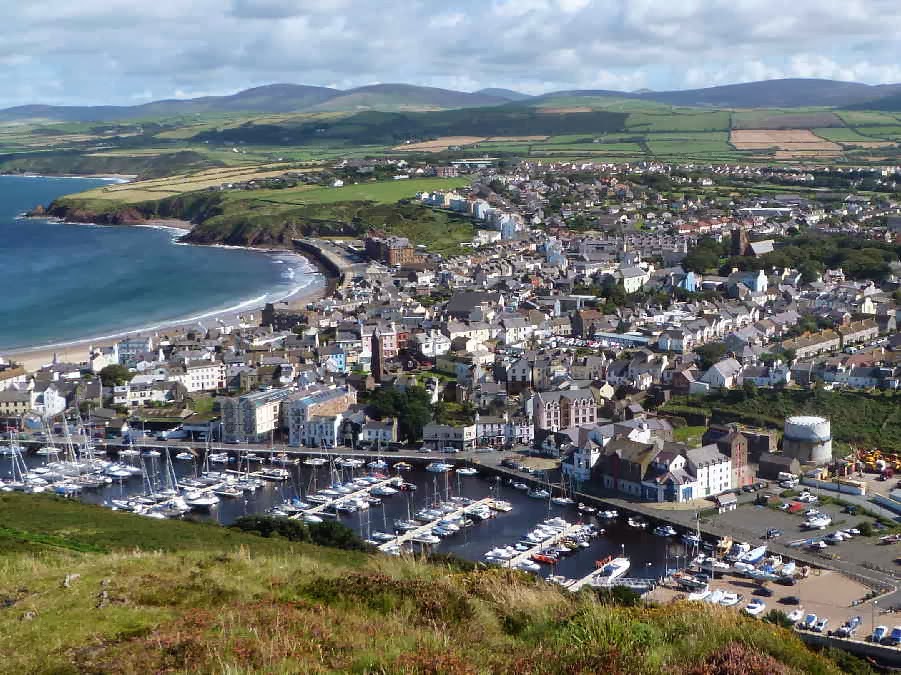Another triangular
walk
Tuesday 18th September,
2012
Another triangular walk, this time on the
east coast - starting at Groudle Glen just north of Douglas, near the
shore.
Continuing the theme from last week, we
decided to do this one "in reverse" as well, starting along the footpath next
to the Groudle River instead of the usual direction up to Conrhenny via Baldrine
and then back past the dams and along the river. A change of direction changes
the walk more than one would expect. The views ahead differ and also I tend to
pay more attention to the first part of the walk. Towards the end I am just
concentrating on surviving until we get back to the cars.
It was very pleasant ambling alongside the
river in the sheltered glen, particularly because the first part of the footpath
had been repaired. It used to be very muddy and parts had been almost washed
away during the last floods. We were amused to come across this fellow . . .
. . . he had been carved from the trunk of a
conifer growing between the path and the stream. These carved figures seem to
be springing up everywhere. The first ones that we saw were in Sulby Glen, but
on the last walk we saw a carving of "Fenella", a Walter Scott character, above
the Fenella Beach car park, gazing across the causeway towards the site of her
famous fictional leap from the castle walls.
The path through the glens goes under two
bridges. The first is a combined bridge for the road to Onchan Head and the
Manx Electric tram line. I don't know when it was built but it is likely
to have been towards the end of the nineteenth century. The tram from Douglas
to Laxey has been running since 1894. Old bridges always seem to be much more
attractive than the modern concrete designs.
Nature has also tried to bridge the stream.
There were a series of old trees that had been uprooted in the winter gales -
very tempting for an adventurous child to climb across.
After passing under the second road bridge we
left Groudle Glen and entered Molly Quirk's Glen. A popular story on the Island
is the the Glen was named for a rich woman who was robbed and murdered near the
river. Her ghost is said to wander through the glen. There is no evidence for
the murder story . . . and we encountered no ghosts (not even a wooden carving
of a ghost!)
When we reached Little Mill Road, we had to
leave the footpath and walk up the tarred road towards the dams. I saw the
first Goldenrod flowers (Solidago virgaurea) which we have encountered this
summer. Their stems were rather floppy - not at all rod-like - because they
were growing on the damp and heavily shaded banks at the side of the road. The
only other place that I have seen wild Goldenrod is on a wall near Ballure
Bridge.
Further on we caught our first glimpse of Kerrowdhoo Dam, the lower of the two
dams.
Then we walked past the higher dam, Clypse.
The dark water isn't polluted. It is stained by the water seeping down through
the peat on the hillsides. I have never seen the dams as full as this before -
and this should be the driest time of year before the winter rains
start!
Over a stone wall, I saw a group of horses in
a field. I am sure these must be some of the horses that pull the trams along
Douglas Promenade as I have heard that they spend their winters up
here.
We walked up the boardwalk above the dams
until we reached the stony road that leads up to Honeyhill. Then we took the
path across to the Conrhenny Road. This turned out to be a mistake. It was
more like a boggy stream than a path. While I was checking the Molly Quirk
story, I came across a comment on a "glenology" website by someone who was
amused about the term "river" being used for the smallest of streams on the
Island. He wrote "You . . . notice that anything with water in it is a river
on Mann." Well, using that definition our footpath definitely qualified as a
river.
The only good thing was coming across a nice
patch of Devil's-bit scabious (Succisa pratensis) at the side of the path. The
wind was coming up and tossing the flowers around, so I had to take this photo
while I was holding the flower stem with one hand and the camera with the
other. The Devil's-bit scabious is similar to the Field Scabious that we saw by
the Peel to Douglas railway line about a month ago, but lacks the larger ring of
florets around the edge of the flower.
As we approached the Conrhenny plantation, I
looked back towards Douglas Head.
And the last photo that I took was of an
unusually civilised refreshment break at a convenient picnic table by the Onchan
Millennium Cross.
After that it was downhill all the way, along
not very photogenic roads and a narrow footpath, back to Groudle. I had thought
of taking a detour to the quaint Old Church but it was getting late and clouds
were gathering. We had avoided the predicted scattered showers for two weeks
and didn't want to push our luck too far. Luckily we just managed to finish the
walk before the rain came - but drove through a couple of showers on the way
home.
No photo walks for the next couple of weeks.
Trevor and Dorothy are off on another trip to the mainland. I think they have
photographed everything on the Island so many times that they have to travel
across now to find fresh subjects! I asked Dorothy about this and she replied
"We photograph the same things . . . but different!"

























